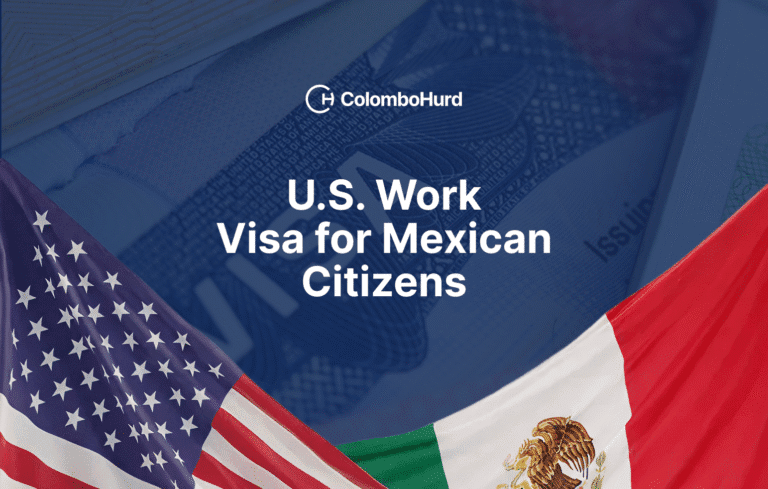
On This Page
Moving from H-1B Employment to the EB-5 Immigrant Investor Program
If you’re in the United States on an H-1B, your green card prospects often depend on one thing you don’t control: your employer. The traditional labor certification process usually stretches out for years. It begins with a prevailing wage determination that can take around a year, continues with several months of recruitment, and then involves additional waiting while the Department of Labor reviews the case. All of this happens before you even reach the I-140 filing stage. If your company restructures or lays off people during the process, you may have to start over with a new sponsor.
The H-1B-to-EB-5 route offers an alternative path. Instead of relying on an employer to stay committed and stable throughout a lengthy PERM process, the EB-5 Immigrant Investor Program allows you to take control of your own green card journey through a qualifying investment with clearly defined requirements for capital and job creation. In many cases, H-1B professionals can file the EB-5 petition (Form I-526E) and the green card application (Form I-485) together, gaining work and travel authorization while the case is pending. This approach avoids the long wait associated with the two-year PERM process.
This guide breaks down what H-1B holders need to know about EB-5: who qualifies, current investment thresholds, and the step-by-step path to move from H-1B to EB-5 while gaining more control over your immigration future.
What Is the EB-5 Immigrant Investor Program?
The EB-5 Immigrant Investor Program is a U.S. permanent residency option based on a qualifying investment and job creation, rather than employer sponsorship. An investor places capital in a for-profit U.S. commercial enterprise, and that investment must lead to the creation or preservation of at least ten full-time jobs for qualifying U.S. workers. The minimum investment is currently $800,000 in a Targeted Employment Area or rural area, or $1,050,000 in other locations.
For professionals in H-1B status, EB-5 shifts the focus from PERM and employer petitions to an investment-driven strategy. The central questions become whether the selected EB-5 project satisfies program requirements, whether the capital remains at risk in a qualifying enterprise, and whether the investor can document a lawful, traceable source of funds, often supported by years of H-1B wages, bonuses, savings, and other assets.
For a deeper overview of the EB-5 framework, Colombo & Hurd’s EB-5 Visa resource page provides additional detail.
Why H-1B Professionals Are Turning to EB-5
The H-1B-to-EB-5 path is attracting more professionals seeking a more straightforward route to permanent residency. Within the employment-based system, H-1B status allows professionals to build a U.S. career, but does not necessarily provide a predictable timeline to permanent residency. Employer-sponsored routes like PERM, EB-2, and EB-3 can be slow, fragile, and highly dependent on corporate decisions, so a layoff, policy change, or stalled case can set the process back years. This is especially true for nationals of heavily backlogged countries such as India or China, where traditional employment-based queues can stretch far beyond a family’s planning horizon.
More Control and Predictability Through Investment
EB-5 offers a different model. Instead of relying on an employer, the case is built around a qualifying investment, lawful source, and path of funds, and job creation, factors that many professionals experience as more predictable and within their control. For applicants from historically backlogged countries, including India and China, EB-5 can also provide faster or immediately available visa numbers, creating a significantly quicker route to permanent residence compared with EB-2 or EB-3 in many cases.
In addition, eligible H-1B holders can often file the EB-5 petition (Form I-526E) and the adjustment of status application (Form I-485) concurrently, gaining work and travel permits while the case proceeds and, in many instances, bringing older dependent children into the process before they age out. Importantly, EB-5 offers independence from a single employer, greater control over timing, and a more predictable route to permanent residency for the entire family.
How Policy Changes Are Affecting H-1B Planning
Recent discussion of higher H-1B filing costs and possible structural changes to how new petitions are evaluated has also prompted employers and professionals to re-examine how much of their future should rest on a single nonimmigrant category. Against that backdrop, EB-5 stands out because it is governed by a defined investment framework and specific job-creation requirements, rather than by employer-driven filings or internal corporate priorities.
Another reason EB-5 draws interest in the H-1B context is that the two categories work together. H-1B’s dual-intent nature allows individuals to continue in their current roles while an EB-5 case is prepared and filed. For some, maintaining H-1B status while building an investor-based path in parallel strikes the right balance between career continuity and long-term immigration security.
For a broader comparison of long-term options, see Colombo & Hurd’s H-1B Alternatives article.
EB-5 Eligibility Requirements for H-1B Professionals
Eligibility for the EB-5 program centers on the investment and the lawful source of that capital. EB-5 does not require an advanced degree, a specific job offer, or an employer-sponsored petition. The core requirement is placing the required amount of capital into a qualifying U.S. commercial enterprise and meeting the program’s job-creation standards.
Most investors qualify by showing that their funds came from lawful, traceable sources such as salary, bonuses, stock compensation, business income, asset sales, loans secured by personal assets, or gifts. For individuals in H-1B status, years of documented U.S. earnings and tax filings often provide a strong foundation. The focus then shifts to selecting a compliant project and ensuring the investment structure satisfies EB-5 rules, including the “at risk” requirement and the job-creation framework. Minimum investment thresholds are set by statute and vary based on project location.
For more detail on current minimums, see Colombo & Hurd’s EB-5 investment amounts guide.
Evidence Needed for a Strong EB-5 Case
A well-prepared EB-5 petition depends on clear documentation showing how the investment was obtained and how it was transferred to the qualifying enterprise. The most essential element is the “lawful source and path of funds,” which requires financial records tracing the investment capital from its origin to the EB-5 project. For many individuals in H-1B status, this includes earnings in the United States, tax filings, bank records, equity compensation, and other income that can be traced through standard financial statements. When funds come from loans, gifts, or the sale of assets, additional records are needed to show how those funds were originally acquired.
Project-related evidence also plays a central role. Regional center investments typically include business plans, economic reports, offering documents, and job-creation analyses prepared by the project team. A direct EB-5 investment requires its own set of business records, including operating agreements, financial projections, and materials explaining how the enterprise will create at least ten full-time jobs. Strong petitions tend to share the same characteristics: clean financial tracing, consistent records, and a clear connection between the investment and the project’s job-creation plan.
For detailed guidance on documenting your capital, see our guide EB 5 Funds Source: How to Prove Lawful Investment Capital for Your Visa.
Step-by-Step Guide: Transitioning From H-1B to EB-5
Every case is unique, but the outline below reflects the steps most H-1B investors typically follow in the EB-5 process, and the role our firm plays at each stage.
1) Assess EB-5 in Light of Your H-1B Timeline
We begin by reviewing your available capital, remaining H-1B time, and any existing PERM or I-140 filings to determine whether EB-5 aligns with your goals and timeline. Our team evaluates your immigration history and outlines the most strategic path forward.
2) Choose an EB-5 Project and Structure
You select the regional center or direct investment that best fits your financial objectives, while we conduct the immigration vetting. This includes reviewing the project’s USCIS approval history, compliance, and job-creation methodology to confirm that it supports a strong filing.
3) Document Lawful Source and Path of Funds
We guide you in gathering the financial records needed to document how your investment funds were earned and transferred. Our team analyzes these records, identifies any gaps, and prepares the detailed source-of-funds explanation required by USCIS.
4) File the Form I-526E (or I-526) Petition
Once your project documentation and financial records are complete, we prepare and file the I-526E (or I-526) petition. This submission includes the full set of source-of-funds evidence and project documents needed for USCIS to evaluate your EB-5 eligibility.
5) Pursue Adjustment of Status or Consular Processing
When a visa number is available, we prepare the adjustment of status filing (Form I-485) or guide you through consular processing.
6) Receive the Conditional Green Card
Following approval and final processing, you receive a two-year conditional green card. Our team remains available to respond to USCIS notices and assist with practical questions during this period.
7) File Form I-829 to Remove Conditions
As the two-year conditional period ends, we prepare and submit Form I-829 to show that your investment remained at risk and that the project created the required jobs. This filing completes your transition from conditional to permanent residency.
Common Misunderstandings About the H-1B to EB-5 Path
Several recurring misunderstandings often arise when H-1B professionals first consider EB-5. One common assumption is that EB-5 always requires running a business full-time, hiring employees directly, and managing day-to-day operations. In fact, the regional center model allows a more limited role, in which job creation is measured through economic analysis rather than direct hiring, making the program workable for those who continue in H-1B roles.
Another misconception is that only cash savings qualify for EB-5. Capital can come from many lawful sources, including earnings, bonuses, stock sales, gifts, loans secured by personal assets, business profits, or the sale of property, provided the path of funds can be documented. For many H-1B professionals, U.S. salary records serve as the foundation for this tracing.
There is also concern that EB-5 conflicts with H-1B status. Because H-1B is a dual-intent category, pursuing EB-5 does not jeopardize current status or travel ability. Many investors remain in H-1B status throughout the process, file for adjustment of status when available, and continue their professional careers without interruption.
Finally, some assume that investment funds must stay locked in permanently. EB-5 capital must remain at risk until the investor becomes eligible for removal of conditions; thereafter, repayment depends on the terms of the project, the business model, and the exit strategy. EB-5 is an investment with risk, but it is not a lifetime commitment of funds.
Frequently Asked Questions About the EB-5 for H-1B Professionals
Yes. The H-1B category permits dual intent, so a pending EB-5 petition does not disrupt H-1B status or the ability to keep working.
No. EB-5 and PERM may proceed at the same time. Many individuals maintain the employer-sponsored path while pursuing EB-5 for added predictability.
Yes. A spouse and unmarried children under twenty-one qualify as derivative beneficiaries and follow the principal investor’s timeline.
No. The location of the investment does not restrict where the investor resides or works in the United States.
No. EB-5 funds must be “at risk,” meaning there can be no guaranteed return or guaranteed repayment. Careful review of the project’s structure and business model is an important part of the process.
Conclusion
The H-1B-to-EB-5 transition is not the right solution for every situation. Still, it can be a strong option for those who value control over timing, stability for their families, and a long-term commitment to living in the United States. Careful project selection, thorough documentation, and a clear understanding of each stage of the process are essential to making EB-5 work as intended.
Related resources:





